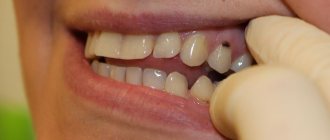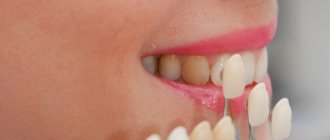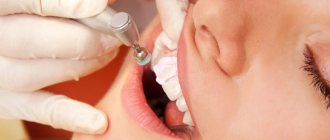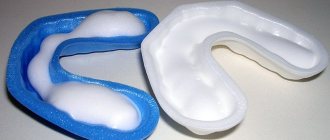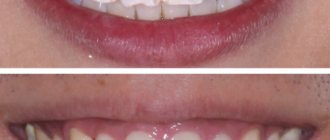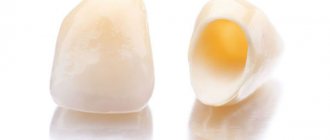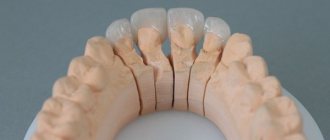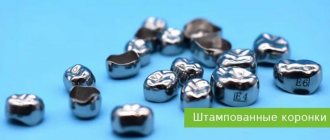Teeth polishing in Moscow
Unfortunately, not many people understand the benefits of teeth polishing.
However, the effect of the procedure is noticeable almost immediately: the enamel becomes white, smooth and pleasant to the touch. In addition, there is a practical benefit from this, because the absence of cracks and protrusions makes the teeth more resistant to bacterial plaque. The deposits simply will not be able to take hold, resulting in the oral cavity remaining clean and healthy for much longer. You can get polishing done at the Moscow dental clinic Kingdom of Smiles. The company has been employing highly qualified hygienists and dentists for many years, who constantly attend various seminars and courses in order to improve their skills and gain new knowledge. By entrusting your teeth to real professionals, you can be sure of excellent results and comfortable service.
Teeth grinding tools
For polishing, special tools with rotating heads are used, which are fixed to the contra-angle tip of the drill. The principle of operation is the complex use of cleaning mechanisms and abrasive pastes.
The following are used as nozzles:
- rubber cups – suitable for treating flat tooth surfaces;
- cone-shaped brushes – designed for lumpy areas;
- polishing strips (strips) coated with aluminum oxide or diamond coating - for cleaning proximal surfaces, that is, the area of contact between the teeth.
During the polishing process, the dentist alternately uses several types of abrasive pastes, ranging from coarse to medium- or fine-grained.
The degree of abrasiveness of the paste is indicated by the RDA index:
- 250 (blue) – coarse-grained mixture for removing dense deposits;
- 170 (green) – medium-grained;
- 120 (red) – fine paste;
- 40 (yellow) – extra soft for final polishing.
The main component (abrasive) of polishing pastes is silica, ground zircon, silicate or zirconium oxide. The preventive effect is provided by such useful components as ionized fluorine and xylitol.
Abrasive tooth polishing paste
What is teeth polishing
Usually, after professional hygiene or whitening, teeth become a little rough. This is due to the fact that stone and plaque tend to penetrate the enamel structure, and after their removal, the adhesion sites remain unfilled. Upon closer inspection, shallow grooves and ridges can be found. If they are not eliminated immediately, then after a few months the person will again need the help of a hygienist.
In addition, polishing is needed immediately after installing the filling material. This is explained by the fact that the composite has a heterogeneous structure and at the same time rises slightly above the surface of the natural tooth. Because of this, it can become an ideal place for harmful bacteria and food particles to settle. Over time, all these deposits will become dense and turn into stone, which cannot be dealt with at home.
Polishing is a mandatory step when removing orthodontic braces, as well as after any surgical interventions during which the tooth was prepared. The main goal is to obtain a perfectly smooth base. This is important not only for aesthetic reasons, but also for hygienic reasons. Smooth enamel is better processed by salivary fluid, which means it is less susceptible to pathogens.
Indications for cleaning
After visiting the doctor's office, the patient may be prescribed a polishing. Cases after which the dentist can send for the procedure:
- Installation of implants, fillings.
- whitening .
- Professional clinical enamel cleaning.
- Removal of tartar and visible plaque.
- Comfort after cleaning with products containing abrasive particles.
- Correction of the cutter shape.
- Prevention of irritation of the mucous membrane.
You should not refuse to straighten the enamel; the doctor better understands the condition of the teeth. If the doctor insists on the procedure, then it is really necessary.
How to polish teeth
Typically, grinding or polishing is carried out at the final stage of treatment or cleaning, so first the doctor carries out all the necessary manipulations and only then begins to level the enamel. To do this, it is very important to choose the right paste and brush of optimal hardness. The sequence of manipulations is always the same. The smoothest areas are leveled first, after which the chewing sides and spaces between individual units begin to be processed. Since different pastes are used during the work process, the order in which they are applied is also important. Formulas containing large abrasives are taken first, and then small ones.
After the tooth is smooth, it is coated with fluoride varnish to protect it from acids and bacteria that enter the mouth in large quantities every day with food and drinks. For his work, the hygienist uses a drill and various attachments. During the processing process, the enamel does not heat up much, this is due to the minimum number of revolutions of the device - no more than 5000. This allows us to confidently say that there is no harm from polishing.
Different teeth require different attachments. Cup-shaped options made of high-quality rubber are suitable for smooth crown parts. Cone-shaped brushes do an excellent job with the lumpy surface of chewing units, and plates coated with diamond chips are indispensable for polishing the side edges, that is, all hard-to-reach areas. The pastes also differ in their composition and properties: blue is used for roughing, green is used at an intermediate stage, and red and yellow are used to complete cleaning and polish especially delicate areas.
How is the procedure performed?
The process takes place under the strict supervision of a dentist. The first step is professional cleaning - plaque is removed from the enamel. Only after cleaning is completed can polishing begin.
The whole procedure takes no more than 40 minutes. The session is performed without anesthesia. The choice of nozzle is of great importance. It is selected based on an assessment of the current condition of the tooth and the level of sensitivity.
During grinding, a specially selected paste is used. It is applied to a holder connected to the device.
The part with the paste applied to it begins to rotate at high speeds - in some cases they can reach up to five thousand per second.
There is no need to worry about the possibility of damage to the enamel, because a professional dentist will not allow this to happen.
Teeth polishing methods
Based on preliminary diagnostics and taking into account the purpose of the procedure, the dentist chooses one of the polishing methods presented today. Mechanical treatment is considered classic; it requires only a special device, which is available in absolutely every clinic. Ultrasonic grinding is used less frequently, due to the need to purchase expensive equipment.
The principle of operation in this case is slightly different: plaque and unevenness are broken into small particles due to the action of waves of different frequencies, and then washed away with strong pressure of water. This method is suitable for interdental spaces and even for tooth roots, since ultrasound can penetrate even to great depths. Another method involves using a sandblasting device. The essence of its action is to supply liquid with fine abrasives under strong pressure. The main advantage is that the risk of soft tissue injury is minimal. Also, some specialists use a laser, but a significant disadvantage is its high cost and availability only in the largest organizations.
Why do you need to polish your teeth?
Despite the fact that grinding and polishing are included in the complex of measures for removing stone, they can also be used as independent procedures aimed at improving the general condition of the enamel. Grinding is performed in order to remove unevenness and microcracks from the enamel surface. Thus, grinding the enamel helps reduce plaque and slows down the formation of stones. In addition, grinding helps improve the general condition of the enamel and is one of the preventive measures for the development of caries. Polishing is carried out after grinding. It is intended for the final leveling of micro-irregularities on the enamel that could remain after grinding. In general, polishing is more cosmetic in nature and provides a slight whitening effect.
Contraindications
As mentioned earlier, polishing is a necessary step in many dental procedures. But there are situations when you have to refuse to implement it. The most common cause is bleeding gums. This can occur both due to the presence of an advanced stage of the disease, and due to the characteristics of the tissues, when they are very delicate and react to the slightest mechanical contact.
Also, a temporary limitation will be the diagnosis of periodontal disease or periodontitis in the acute stage, pulpitis, cysts or granulomas in the patient. The planned procedure will also have to be postponed for a short time if there are multiple carious cavities in the oral cavity. Only after completion of treatment can you begin grinding.
Most methods are not suitable for those who have very thin and sensitive enamel. Even if polishing is successful, a person may later experience unpleasant symptoms: pain, reaction to cold, etc. If the patient has a tendency to allergic reactions, the medications used by the doctor may not be suitable for him. Other contraindications include oncology, diabetes, epilepsy, kidney and heart diseases.
Possible consequences
Despite the development of technology, polishing tooth enamel is still not the most pleasant procedure for which you should prepare in advance. To ensure the psychological and physical comfort of the patient, local anesthesia is used to eliminate pain.
It is also worth considering that after treatment, the sensitivity of the enamel increases, so the reaction to sudden temperature changes after the effect of painkillers wears off can be unpleasant. It is recommended to follow medical recommendations that prescribe a temporary exclusion of hot and iced foods and drinks from the diet, as well as a reduction in the amount of solid food, the consumption of which leads to an increase in mechanical stress on weakened enamel.
Painless teeth polishing
Before making an appointment with a dentist, many people wonder whether treatment and grinding are painful. Don't worry, because all modern methods are absolutely safe and painless. During the procedure, the enamel is erased by only 0.1 mm; this does not require anesthesia. In addition, innovative equipment makes it possible to forget about overheating of tissues, which can cause the patient to feel discomfort and an unpleasant odor.
If there is still discomfort, this indicates increased sensitivity of the upper layer of tooth tissue. In this case, professionals strongly recommend fluoridation. After treatment with fluoride-containing preparations, the effect persists for several years. If necessary, the procedure can be repeated, as it does not cause any side effects.
In rare cases, an anesthetic injection is given before grinding begins. This allows you to completely relax and trust the master. However, it is important to understand that symptoms may reappear after the freeze has stopped. If this happens, medication may be taken. They are usually prescribed in a clinic, so do not exceed the recommended dose.
What will be required after the procedure
The recovery process itself takes little time. Many patients experience increased sensitivity during the first 24 hours after visiting the dentist. For this reason, it is worth limiting the consumption of food that is too hot or cold.
For two or three days, you should also give up drinks and foods that can strongly stain the enamel. These include tea, coffee, some types of vegetables, fruits and berries.
At the Novodent clinic in Khimki, our doctors will perform all the necessary operations, both cleaning and subsequent grinding of the enamel.
We use high-quality compounds and proven tools, the appointments are conducted by experienced dentists - this guarantees that there will be no damage to the enamel during the process and the result will be exactly what you expected.
To schedule your first free consultation, call or submit a request on the website. We guarantee the quality of the result and offer affordable prices.
Before and after teeth polishing
Polished enamel is very different from enamel that has not yet been professionally processed. The photo taken before the procedure clearly shows the presence of grooves and bulges on which plaque and food residues easily settle. After grinding, not a trace remains of them, the enamel becomes incredibly smooth and delicate, pleasant to touch with your tongue. In addition, it becomes several shades lighter.
Before starting polishing, it is very important to prepare the oral cavity: remove stones and plaque, and protect the lips and mucous membranes from accidental contact with rotating elements of equipment. Since you will have to sit motionless with your mouth wide open for about 20-35 minutes, it is best to install a retractor - an expander that fixes the lips in the desired position.
Thick cotton rolls are placed between the gums and rows of teeth; they prevent saliva from entering and reliably protect against accidental damage. If actions need to be performed only on one area of the jaw, then they are separated by special plates. A prerequisite is to wear glasses; they prevent liquid and paste particles from getting into the eyes. In just one session, the enamel is noticeably transformed, and the risk of re-deposition of plaque is reduced several times.
The benefits of professional teeth cleaning, its features
Professional teeth cleaning gets its name from the fact that it is carried out by a specialist, using professional tools and technologies that make it possible to qualitatively remove both light plaque and a more complex form - tartar. After the procedure, the teeth, gums, and subgingival pockets are completely freed from plaque, and the oral cavity is cleansed of pathogenic bacteria. At the same time, the teeth return to their beautiful, natural color and shine. Comprehensive teeth cleaning is one of the ways to take good care of the health and beauty of your teeth.
In what cases is it necessary to have professional teeth cleaning:
- If you want to keep your teeth beautiful, strong and healthy for a long time. Professional hygiene helps prevent the occurrence of caries and gum inflammation;
- After undergoing complete dental treatment to maintain the achieved positive result over time;
- Before the procedure of treatment, prosthetics, orthodontic dental treatment, implantation. Thanks to comprehensive cleaning before dental treatment, the condition of the gums improves, it becomes possible to detect caries in the early stages of development, whiten the enamel to a natural shade and simplify the process of installing fillings.
There are no contraindications to the procedure of professional teeth cleaning, but there are restrictions on some techniques, so only the attending dentist can correctly select the set of necessary procedures.
Next, information about the stages of professional teeth cleaning will be presented in more detail to make it more clear what benefits this procedure brings.
Rehabilitation after teeth polishing
Recovery after the procedure does not take much time; immediately after leaving the dental clinic, a person can return to their usual lifestyle with virtually no restrictions. In the first few days, it is recommended to adhere to a white diet, that is, give up coloring foods, coffee, black tea, red wine, fruits, beets, etc. Also, the diet should contain a lot of dairy products, which contain calcium necessary for teeth.
To maintain the effect, you will have to listen to the advice of your dentist and follow some rules. First of all, this concerns care and the daily cleansing ritual: for this it is best to purchase a soft brush and a paste with a low content of fine abrasives. You cannot drink colored drinks, eat viscous and very sticky sweets, or chewing gum. The temperature of the food should be no higher or lower than room temperature, otherwise it can cause increased pain.
It is strongly recommended to forget about cigarettes and hookah for at least a few days. Tobacco smoke contains many harmful acids, which negatively affect the protective properties of enamel and accelerate the formation of stone. Cleaning and polishing should be done at least once a year or six months if you have bad habits. This will protect yourself from developing more serious problems with your teeth and the body as a whole.
Required materials and tools
Various materials, tools and the latest technologies are used for polishing. They differ from each other in size, shape, design, etc.
You can include it here:
- use of abrasive pastes;
- strips, discs and polishers;
- finishing stones, abrasive stones;
- brushes and rubber cups.
Below we will look at each type in more detail.
Bors
The main distinguishing feature of burs is the attachments, as well as the material used for production.
There is a special marking that makes it easier to select a bur to perform a particular manipulation:
- diamond burs with a yellow or red ring - allow you to remove excess filling material;
- attachments with white stripes - allow you to polish your teeth until they are smooth.
An example of what burs look like
Carbide burs can also be used and serve as the final step in the restoration.
Finir
These are attachments for drills, made in the form of a spiral. Doctors can polish any material used in dentistry. The number of faces can be different, from six to thirty pieces.
Abrasive stones
These are rotating dental instruments, the material used for manufacturing is different, the degree of roughness also differs from each other.
Other attachments used in dentistry
Polishers
The tool allows for high-quality polishing. The ligament is silicone and elastic, the degree of rigidity is medium. The shape of the polishing element can be conical, cylindrical, or convex.
Strips
These are flexible strips made of polyester. Different materials with varying degrees of grain size can be used as a coating. Length up to 18 centimeters.
Suitable for polishing contact surfaces
Pastes
These are special pastes designed for polishing and cleaning teeth. Available in syringes and tubes. The composition contains fillers with abrasive particles. They can be standard, thin or extra-thin.
Cosmetic enamel restorations: natural biomimetic layering technique
There is no doubt that the human face is one of the components of the overall profile of external attractiveness. If we group the elements of the face by importance, the mouth, of course, occupies one of the first places: it forms both the overall facial expression and helps to display feelings of friendliness, agreement or gratitude. A smile, in turn, expresses a feeling of happiness and pleasure, but even with other emotions it has an extremely important facial meaning. In turn, a smile consists of the profile of the face, the profile of the gums, teeth and the emotion that it expresses. Therefore, to correct a smile, it is necessary to achieve harmony of these four components, also taking into account the specifics of their individuality. Lips are a kind of frame for a smile, and teeth and gums represent a picture placed in this frame. A healthy and harmonious smile has a positive impact on the development of feelings of trust and confidence in a person. Even minor defects in one of the components of a smile, such as a violation of the contour or color of the front teeth, compromise the overall aesthetic condition of a person’s face.
This article will discuss the role of hard tissue, especially enamel, in shaping the aesthetic appearance of the smile, and will present a new minimally invasive technique for creating a more youthful smile profile in compromised clinical situations with minimal biological loss.
The role of tooth enamel
Enamel is one of the most important structures of the tooth, both from a functional and aesthetic point of view. Essentially, enamel is a uniquely organized nanostructured material that forms the outer covering of teeth. It consists of crystalline calcium phosphate, which makes up 96% of the structure, with the remaining 4% being organic components and water. The organic component of enamel is a breakdown product of the main protein - amelogenin. Mature enamel does not contain cells and does not regenerate, unlike other biomineralized tissues such as bone and dentin.
Loss of enamel surface leads to deterioration of the aesthetic parameters of the smile
Enamel, covering the outer coronal surface of the tooth, must withstand a significant number of acting factors in conditions of constant demineralization and remineralization processes. In such a situation, the loss of a certain layer of the tooth surface is simply inevitable. However, this process is normal during the aging of the body, in addition to which it can also be pathological. The latter differs from the physiological one in that it is accelerated by the action of endogenous and exogenous factors.
Depending on the cause, there are four different types of tooth wear: attrition, abrasion, erosion and abfraction. Each of these processes, in addition to dysfunction and aesthetic parameters of the smile, also affects the general state of health.
Attrition (Figure 1) is the loss of dental tissue resulting from mechanical action between the surfaces of opposing teeth during mastication and parafunctional activity. This process is most often noticeable on the occlusal surfaces of the posterior teeth and the cutting edges of the anterior teeth.
Photo 1: Attricia.
Abrasion (photo 2) refers to mechanical abrasion of teeth, provoked by reasons different from those during the interaction of antagonist teeth. Most often, this process develops when certain exogenous agents are present between the teeth, such as an overly abrasive toothbrush or paste, or during a certain method of brushing teeth.
Photo 2: Abrasia.
Erosion (photo 3a and b) is the pathological wear of teeth caused by the action of chemicals, most often acids of internal or external origin. The rate of erosion progression is also influenced by the quality of saliva (rate of salivation, pH and saliva components).
Photo 3a,b: Erosion.
Abfraction (photo 4) is a pathological process of loss of a layer of the surface of the teeth, which occurs when teeth are repeatedly compressed and bent under the influence of occlusal loads, resulting in the destruction of enamel rods. This process is most noticeable in the area of the tooth neck.
Photo 4: Abfraction.
In addition to these four reasons, the loss of hard tooth tissue can be provoked by developmental anomalies (photo 5a-c), especially amelogenesis imperfecta and dentinogenesis, which are predisposing factors for progressive pathological abrasion.
Photo 5a-c: Teeth with developmental defects: enamel hypoplasia (a), amelogenesis imperfecta (b), dental fluorosis (c).
The relationship between the processes is quite logical: with inadequate enamelogenesis, the tissue is very thin and soft, therefore, it wears out more easily, while with imperfect dentinogenesis, the strength of the bond between dentin and enamel is impaired, which leads to easy separation of these tissues at the interface. The loss of hard dental tissues changes their morphological shape, leads to the development of various types of sensitivity, pulpal complications, discoloration of teeth, loss of vertical parameters of occlusion and associated occlusal disorders. The latter, accordingly, provoke changes in neuromuscular function, chewing efficiency and smile aesthetics due to an imbalance in the horizontal component of the occlusal plane. Loss of the canine route of insertion increases the load on the posterior group of teeth, which consequently causes progressive wear of the molars and an increased risk of chipping of restorations in this area. An unstable state of occlusion, among other things, also provokes biting of the cheeks and tongue during chewing.
Optical characteristics of anterior teeth
As mentioned earlier, teeth undergo changes over the years that directly affect their appearance and color. Due to an increase in the thickness of dentin and a decrease in the thickness of enamel, the parameters of transparency and opacity of teeth also change, which can be explained by the difference in interaction with light when the composition and level of mineralization of hard tissues are disrupted. Enamel transmits up to 70.1% of the light flux, while no more than 52.6% passes through dentin. Thus, it is clear why dentin is the main light former, and enamel is only a modifier.
Optical properties of natural enamel
When working with enamel, you need to understand the specific orientation of enamel prisms in the thickness of the fabric. As a rule, they are located at an angle of 90 degrees relative to the dentin surface. In the cervical region, the prisms depart from their usual horizontal orientation and tilt apically. In the area of the cutting edge, the prisms have an oblique direction, and in the area of the edges they are almost in a vertical position. Due to this change in the orientation of the prisms, the transparency of the enamel also decreases. Enamel also changes the chromatic parameters of teeth due to processes such as reflection, transmission and refraction of light, as well as based on the characteristics of thickness and surface texture. In addition, enamel has the ability to weaken the colors of the lower range, which also affects the chromatic parameters of the tooth. The light reflectance or transmission properties of enamel depend on its texture, the orientation of the enamel prisms and the ability to refract light depending on histological characteristics. Enamel translucency may also be associated with variations in calcification levels, as more porous and less mineralized enamel has higher levels of light dispersion.
Optical properties of dentin
Dentin can be considered as dental tissue that largely determines the overall shade of the tooth. From an optical point of view, dentin is a structure with low transparency and varying parameters of intensity and color saturation. Dentin is relatively opaque because the arrangement of the dentinal tubules allows dentin to exhibit selective diffraction of light, causing some rays to be reflected while others are absorbed. During the development of the organism, primary dentin is replaced by secondary and tertiary dentin, which are characterized by a different structure and composition, and, consequently, other optical characteristics. In elderly patients, a decrease in the diameter of the dentinal tubules causes progressive dentin sclerosis and high color saturation of this structure.
Basic characteristics of teeth
The visual characteristics of teeth change with age and can be categorized into four age groups: childhood, adolescence, middle age and old age.
In childhood (photo 6a-c)
Photo 6a-c: View of teeth in childhood.
Around the age of 10 years, the enamel is characterized by an almost milky white hue, the surface layers are at their most opaque and often look as if they have been frostbitten. In this case, the enamel, as a rule, demonstrates a clear opalescent effect, and its surface with micro- and macrostructure has a very low surface gloss; The cutting edges of the teeth are completely covered with enamel.
In adolescence (photo 7a-c)
Photo 7a-c: View of teeth in adolescence.
Around the age of 20, the enamel becomes less white, and its transparency increases due to the abrasion of the upper layers of the young, opaque enamel. The enamel surface is still microstructured and has a low gloss level. The dentinal areas, although still covered with enamel, become slightly noticeable with a blue and orange tint.
Middle age period (photo 8a-c)
Photo 8a-c: View of teeth in middle age.
During this period, the micro- and macrostructure of the enamel surface decreases, and its surface gloss increases. The enamel becomes more transparent, and dentin shades become more pronounced.
Elderly period (photo 9a-c)
Photo 9a-c: View of teeth in older age.
The enamel is characterized by increased transparency, the shades become closer to bluish and grayish, the microstructure of the enamel is almost absent, and the macrostructure is significantly reduced. Also, at the same time, the parameters of surface gloss increase, dentin looks darker and even less transparent compared to teeth in middle age.
Restoration strategy
Understanding all the specifics of light changes and optical characteristics of enamel, which vary with age, the doctor can ensure that the most artistic and natural restoration effect is obtained. The restoration strategy includes not only the process of modeling the lost layers of tissue, but also the optimal approach to material selection, processing, texturing and polishing. Cosmetic enamel restorations can be successfully used to correct minor violations of the structure of teeth, their brightness and contour parameters. The loss of the surface layer of enamel provokes disturbances in the visual perception of the front teeth, their brightness parameters, contour and the overall aesthetic profile of the smile. Because the enamel layer is quite thin, its loss is often associated with the loss or at least exposure of a certain amount of dentin tissue. Therefore, restoring the natural appearance of enamel requires a careful analysis of the need for restoration and lost dentin tissue, which also affects the parameters of depth, color and type of restoration.
Selection of restorative materials based on optical properties
Although dentin determines the basic color of the tooth and its shade, this parameter is perceived by the observer as somewhat altered due to its modification by enamel tissues depending on its thickness, texture and level of polishing. Enamel does not actually change the shade (color) of the tooth, but only gives it more or less saturation depending on its thickness. Placing a layer of enamel of the required thickness over the dentin area increases or decreases the brightness parameters of the tooth, determining the so-called “liveness” of the restoration. When simultaneously restoring both enamel and dentin tissues, it is necessary to take into account the difference in color transmission by these structures: therefore, more opaque composites must be used for the dentin portion of the restoration, and more transparent shades must be used for the enamel. Considering that a huge amount of restoration materials with different shades of color and transparency parameters are produced all over the world, a systematization of these materials depending on their optical characteristics was proposed (Table 1).
Table 1: Material category.
| Material category | Target | Example |
| Opaque group | To mask discolorations | Beautyfil Opaquer |
| Dentin group | ||
| Opaque dentin | To replace deep dentin layers | Beautifil II A20 (Opaque dentin) |
| Normal dentin | To replace the outer layers of dentin | Beautifil II A2 (universal dentin) |
| Enamel group | ||
| Transparent | For enamel replacement | Beautifil II Enamel HVT |
| Effect group (dyes) | To create specific effects | Beautyfil II Gum shade |
Smile style and surface texture design
The technique of natural-mimetic restorations is consistent with the general psychology of the patient’s perception, as described in the Smile Wheel concept. The design of the smile and the texture of the surface of the teeth should be chosen in accordance with the specific perception of the patient, his individual wishes and vision of treatment results. However, this approach requires a deep understanding of the patient’s personality in order to adequately interpret his subjective aspects. To analyze human personality, the author of the article uses the “DISC” principle, developed by William Moulton Marston, and presented by him in his publication “The Emotions of Normal People” in 1928. Marston proposed that people are motivated by four internal drives that drive his personality images. To describe the processes, he used four behavioral tendencies, which he defined by four letters of the alphabet: D-domination (dominance), I-influence (influence), S-steadiness (stability) and C-compliance (compliance).
D-Smile Style
I-Smile Style
S-Smile Style
C-Smile Style
Based on DISC personality traits, the author classifies smiles into four categories according to Tables 2 and 3.
Table 2: DISCover smile design - dental characteristics.
| Smile design | Central incisors | Tops of fangs | Lateral incisors | IAL (esthetic cutting edge line) | Angle IAL | Tooth axis |
| Smile Design D | Lack of dominance with a square shape | Flat type | Flat and can touch the esthetic incisal line (IAL) | Direct or R = reverse | 90° and more | Straight or slightly deviated |
| Smile Design I | Dominant type with rectangular shape | Rounded flat | Rounded and flat cutting edges that do not touch the aesthetic cutting edge line (IAL) | Descending to direct type | 85-90° | Straight |
| Smile Design | Dominant type with oval shape | Rounded | Delicate, rounded mesial and distal incisal edges that do not touch the esthetic incisal line (IAL) | Descending type | 75-85° | Slightly convertible |
| Smile Design C | Dominant type with triangular shape | Spot | Rounded distal and flat mesial cutting edges that touch the IAL | Descending type | 70-80 ° | Convertible |
Table 3: DISCover smile design: personality characteristics.
| Smile design | Personality characteristics | Suitable for |
| Smile Design D | Goal-oriented, competitive, direct, extroverted, driven by desire, ambitious, strong willed: “Just do it.” | Entrepreneurs, salespeople, legal or judicial professions, managers and related professions |
| Smile Design I | Human and personality oriented, talkative, spontaneous, enthusiastic, persuasive personality type: “Have fun.” | Marketing, public relations, training, tourism, retail and related professions |
| Smile Design | Stable, reliable, conservative, loyal, relaxed, passive, patient type: “Do everything together.” | Training, Education, Finance, Economics, Human Resources, Help Desk, Customer Service, Manufacturing, etc. |
| Smile Design C | Cautious, detail-oriented, logical, organized, diplomatic, "do it right" type. | Accounting, auditing, engineering, medicine, research and development, agriculture, computer programming, etc. |
To achieve optimal restoration parameters, the doctor should always take into account age-related variations in the enamel surface. With age, patients experience a thinning of the covering structure of the tooth, but its modeling should still be carried out taking into account the individual wishes of the patient.
The surface texture of a tooth is determined by three factors:
- Surface texture or degree of surface smoothness/roughness. This parameter can be divided into two categories.
- Macrotexture (vertical and/or horizontal projections and depressions, ridges and grooves visible on the surface of the tooth) and microtexture (small surface irregularities associated with the approximation and calcification of the enamel matrix during tooth formation, depressions, vertical lines and perikymata).
- The gloss or degree of shine of a tooth, also known as simply shine (photos 10 and 11). Luster determines the amount of light reflected on the surface of the crown. This parameter is no less important than the color and contour of the future restoration. It should be noted that shine is not related to age and is genetically or congenitally determined.
Photo 10: Macrotexture with low gloss value.
Photo 11: Microtexture with high gloss value.
Naturo-mimetic layering technique (restoration) (NLT)
Given the complex structure of natural teeth, it is quite difficult to replicate it by simulating the parameters of enamel and dentin. When implementing an NLT protocol, it is important to conduct a detailed analysis of the color, opacity, translucency, texture, surface gloss and special characteristics of teeth to be restored in the future. During NLT restoration, the desired result is achieved by applying the correct thickness of transparent or translucent enamel group materials over a saturated and opaque dentin replacement composite. There are various clinical situations in which it is necessary to achieve the effect of enamel rejuvenation, treatment for which is carried out differently depending on the type of tooth defect and the patient’s wishes regarding restoration. Depending on the clinical situation, the clinician should choose one of the above NLT methods. The natural mimetic layering technique is based on a new classification of shade layers and is divided into the following clinical algorithms.
NLT monolayer
With this technique, the defect is restored with one layer of composite. Typically, opaque shades or materials designed to simulate optical effects are not used in such situations. However, in any case, it is necessary to take into account the parameters of the required restoration layer. The higher color of the area and its opacity justifies the use of a thicker layer. On the other hand, using an enamel shade that is too transparent can cause a gray effect in the restoration, which can again be corrected by the thickness of the layer of material used. At the same time, by increasing the thickness of the dentin material layer, we simultaneously influence the parameters of shade and color intensity, and, therefore, we need to look for a suitable compromise for maximum imitation of natural tooth tissue (photo 13).
Photo 12: NLT monolayer technique.
Photo 13: NLT two-layer technique.
NLT three-layer technique
This technique is used for teeth that require significant color modification, such as when restoring non-vital teeth. The method involves the application of opaque materials, which do not need to be covered with composites intended to form optical effects. As a rule, the opaque group of materials with a three-layer technique is covered with dentin and enamel shades, imitating natural tooth tissue (photo 14).
Photo 14: NLT three-layer technique.
NLT-comprehensive layering technique
Any restoration that requires the use of a group of materials designed to create optical effects is complex. And it doesn’t matter whether it is made only with such materials, or in combination with opaque analogues, or enamel-dentin-substituting composites. Therefore, the technique can be called mono-complex, two-complex or tri-complex. The use of a composite to create a specific effect (to create opalescence, orange or yellow tints, stains, enamel cracks, white spots, etc.) must be justified by the results of careful color analysis and mapping of the tooth surface. This type of restoration is mainly used in the incisal area of the tooth, where the range of translucency and opalescence increases significantly (photo 15-17).
Photo 15: NLT monocomplex technique.
Photo 16: NLT-two-complex technique.
Photo 17: NLT - three-complex technique.
The level of polishing (smoothness) of the surface changes the indicators of chromatic perception, and this parameter is inversely proportional to the lightness of the restoration. The more a surface is polished, the greater its light transmission becomes and, consequently, the brightness decreases. In turn, the absence of polishing (matte finish or the presence of a more pronounced microstructure) leads to a more reflective surface and a brighter restoration.
Photo 18: Naturo-mimetic layering technique (NLT): step-by-step algorithm.
Conclusion
Cosmetic dentistry is one of the fastest-growing branches of dentistry, advancing in tandem with greater awareness and improved patient well-being. After all, everyone wants to have a beautiful, stylish and healthy smile. An aesthetic smile today is the main criterion for patients, indicating that their treatment was successful and in accordance with their own wishes.
Author: Dr Sushil Koirala, Nepal
